Richard Wagner’s
Ring cycle opera (
Der Ring des Nibelungen), composed of four distinct parts, has been translated, written about, and performed regularly since 1869 (when the first part,
Das Rheingold, premiered) and 1876 (when the
Ring cycle was first performed in full). Walter’s annotated translation of
Die Walküre (premiered 1870) is the second in a planned set of four volumes, each looking at one part of the
Ring cycle. This volume is noteworthy for its inclusion of pen drawings by Mott and other relevant colorful historical illustrations placed throughout. The background material offers information on the entire scope of the
Ring cycle, including a quick “1-minute
Ring” that allows readers to start small before launching into the rest of Walter’s substantial work; there’s also a chronology of the almost 30 years Wagner spent composing the cycle. In this volume’s robust introduction, Walter states that his annotations will center Wagner’s work (i.e., the
Ring cycle) and its text as the authoritative sources (instead of drawing on outside commentaries and analyses of the opera). To that end, Walter uses his own English translations of the text of
Die Walküre, keeping in mind the alliterative effects and rhyme scheme that were important to Wagner’s original German (which in Walter’s book is printed alongside the English). At the end of each act of
Die Walküre, Walter gives a one-page review of its events and themes.
VERDICT Walter’s useful introduction to Wagner’s masterpiece breaks down the epic opera’s plot, musical motifs, and poetic structure into digestible pieces of information; ideal for readers with any amount of previous knowledge of the Ring cycle.




Comment Policy:
Comment should not be empty !!!